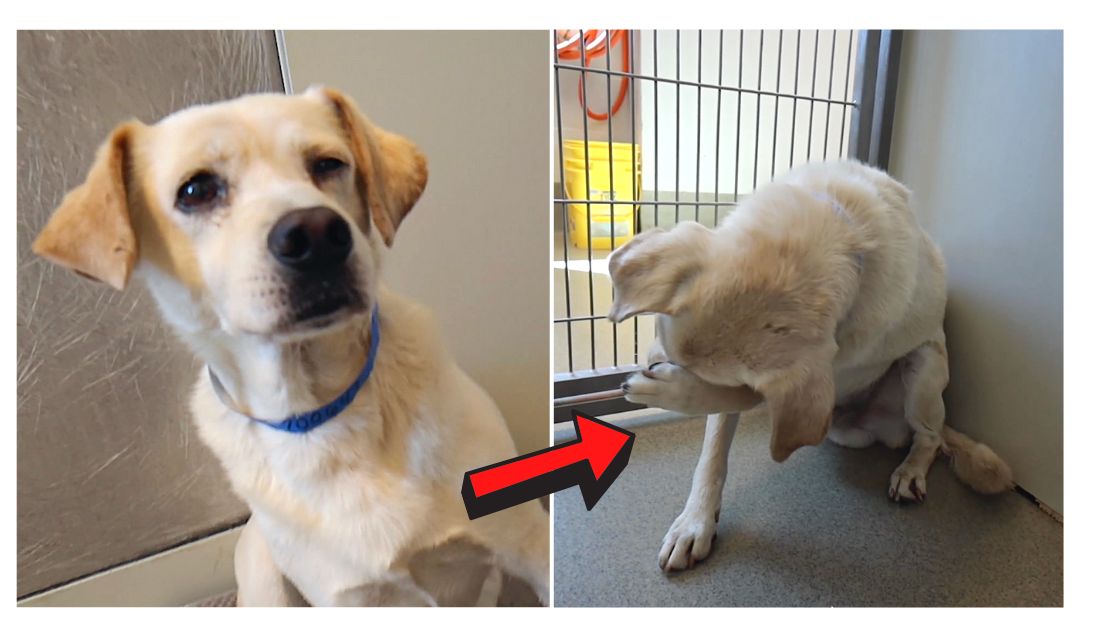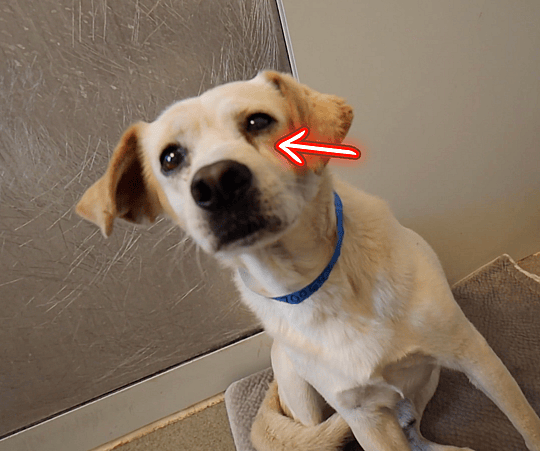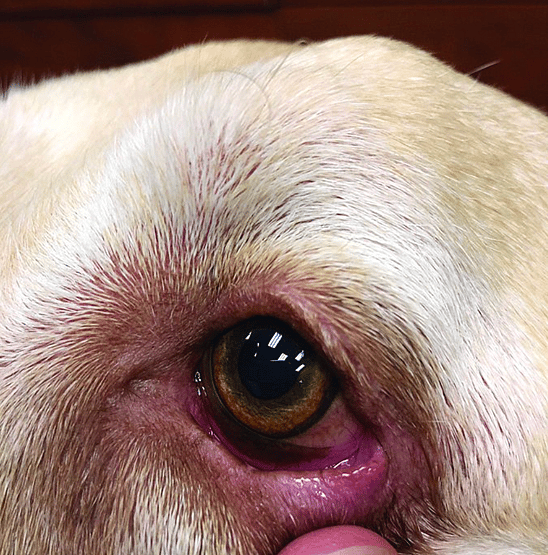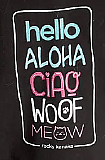Entropion in Dogs: Causes, Symptoms and Treatment

If you have a dog at your shelter or at home, you may have noticed that some of them have eyelids that roll inward, causing irritation and discomfort. This condition is called entropion, and it can affect any breed of dog, but it is more common in some than others. In this blog post, we will explain what entropion is, how it affects dogs, and what you can do to help them.

What is entropion in dogs?
Entropion is a condition where the eyelid (usually the lower one) rolls inward, causing the eyelashes and fur to rub against the cornea (the clear part of the eye). This can cause pain, inflammation, infection, and even ulcers or scars on the eye. If left untreated, entropion can lead to vision loss or blindness.

How do dogs get entropion?
There are several possible causes of entropion in dogs. Some dogs are born with it, due to genetic factors or breed characteristics. For example, breeds with short noses and wrinkled faces, such as bulldogs, pugs, shar peis, and chow chows, are more prone to entropion. Other dogs may develop it later in life, due to aging, injury, infection, or inflammation of the eye. Sometimes, entropion can be temporary, caused by pain or stress that makes the dog squint or blink excessively.

Is entropion contagious?
No, entropion is not contagious. It is not caused by a virus or bacteria that can spread from one dog to another. However, if your dog has entropion and also has an eye infection, the infection may be contagious and require treatment.
Will entropion go away by itself?
No, entropion will not go away by itself. It is a structural problem that requires medical intervention. If your dog has entropion, you should take them to a veterinarian as soon as possible for diagnosis and treatment.

How do you get rid of entropion?
The only way to get rid of entropion is by surgery. Entropion surgery for dogs involves removing a small piece of skin from the affected eyelid and suturing it back in place. This creates tension on the eyelid and prevents it from rolling inward. The surgery is usually done under general anesthesia and takes about an hour. The recovery time varies depending on the severity of the condition and the individual dog, but most dogs can resume normal activities within a few days.
What types of medication are used for dog entropion surgery before & after?
Before and after surgery, your dog may need some medication to ease the pain and prevent infection. Your veterinarian may prescribe eye drops or ointments that contain antibiotics, anti-inflammatories, or lubricants. You may also need to give your dog oral painkillers or anti-inflammatories for a few days. You should follow your veterinarian’s instructions carefully and monitor your dog’s eye for any signs of complications.

How much is entropion surgery for dogs?
The cost of entropion surgery for dogs depends on several factors, such as the location of the clinic, the experience of the surgeon, the complexity of the case, and the type of anesthesia used. The average cost ranges from $300 to $1500 per eye. Some clinics may offer discounts for shelter dogs or multiple pets.
Can any vet do entropion surgery or do I need a specialist?
Most veterinarians can perform entropion surgery for dogs, but some may refer you to a specialist if they are not comfortable with the procedure or if your dog has other eye problems that require more expertise. A specialist in veterinary ophthalmology may have more experience and equipment to handle complex cases of entropion or other eye diseases.

Entropion in dogs is a condition that requires timely attention to ensure the well-being of our furry companions. With proper understanding, prompt diagnosis, and appropriate treatment, affected dogs can enjoy improved eye health and overall quality of life. If you suspect your dog has entropion, consulting a veterinarian is the first step toward ensuring their comfort and well-being.
FAQs
Here are some frequently asked questions about entropion in dogs:
How can I prevent my dog from getting entropion?
There is no sure way to prevent entropion in dogs, as it can be caused by genetic or environmental factors. However, you can reduce the risk by choosing a reputable breeder if you are buying a purebred dog, keeping your dog’s eyes clean and free of debris or irritants, and taking your dog to regular check-ups with your veterinarian.
How can I tell if my dog has entropion?
Some signs that your dog may have entropion include: redness, swelling, or discharge from the eye; excessive tearing or blinking; rubbing or scratching the eye; squinting or closing the eye; sensitivity to light; cloudy or dull appearance of the eye; or vision problems.
How long does it take for a dog to recover from entropion surgery?
The recovery time for a dog after entropion surgery depends on several factors, such as the severity of the condition, the type of surgery performed, and the individual dog’s healing ability. Generally, most dogs can go home the same day or the next day after surgery, but they may need to wear an Elizabethan collar (a cone-shaped device that prevents them from licking or scratching their eye) for a week or two. They may also need to visit the veterinarian for follow-up exams and suture removal. Most dogs recover fully within a month after surgery, but some may need additional procedures or treatments if complications arise.
What are the risks or complications of entropion surgery for dogs?
Entropion surgery for dogs is generally safe and effective, but as with any surgery, there are some risks or complications that may occur. These include: bleeding, infection, inflammation, or scarring of the eye or eyelid; recurrence of entropion or development of ectropion (a condition where the eyelid rolls outward); dry eye syndrome (a condition where the eye does not produce enough tears); or damage to the cornea or other parts of the eye.
How can I help my dog after entropion surgery?
You can help your dog after entropion surgery by following your veterinarian’s instructions carefully and providing them with a comfortable and calm environment. You should keep your dog’s eye clean and dry, and apply any medication as prescribed. You should also prevent your dog from rubbing or scratching their eye, either by using an Elizabethan collar or by supervising them closely. You should also avoid exposing your dog to bright light, dust, wind, or other irritants that may harm their eye. You should monitor your dog’s eye for any signs of pain, infection, or abnormality, and contact your veterinarian if you notice any problems.
Is entropion surgery painful for the dog?
Dogs are typically placed under anesthesia during surgery and should not feel any pain.
Can entropion recur after surgery?
While surgery is usually effective, in some cases, additional procedures might be needed.
Can entropion cause blindness?
If left untreated, severe entropion can lead to corneal ulcers and vision loss.
Can cats gets entropion?
Entropion is not exclusive to dogs; it can affect cats as well. Just like in dogs, entropion in cats is a condition where the eyelids roll inward toward the eye, causing the eyelashes or hair to rub against the cornea. This can lead to discomfort, irritation, and potential damage to the eye’s surface. The causes, symptoms, and treatment options for entropion in cats are similar to those in dogs. If you suspect your cat has entropion, it’s important to consult a veterinarian for proper diagnosis and treatment.




